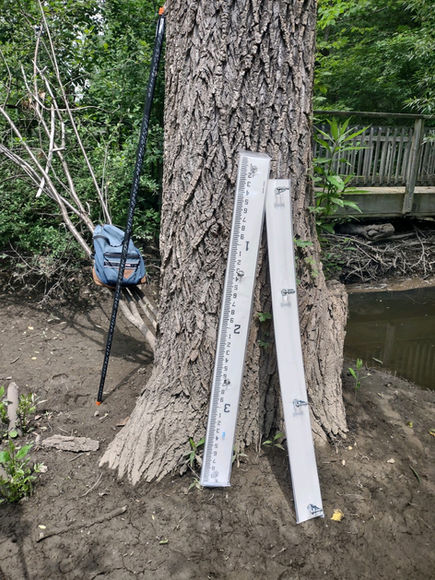

Entering the
Wetland
Welcome in to the wetland. In February of 2024—after discovering a dam on Galloway Creek—we confirmed via trail camera that our campus had become home to a very happy pair of beavers. They had created a wetland where there wasn’t one before, complete with pond, lodge, and an already burgeoning population of new wildlife. Soon after their discovery, the Native American Student Group held a naming contest. The winning names were Waabigwan (“flower” in the Ojibwe language) for him, and Noosookaa (“soft and fluffy” in the Ojibwe language) for her, which we shorten to Waabi and Sookaa. Our pair have not only brought new research opportunities and curricula to our campus, they have ignited awe and brought joy to our community and beyond. Beavers are great community organizers, and Waabi and Sookaa’s abilities have extended to places far beyond their own pond. They are the inspiration for this project. We invite you to envision what it would be like to rewater the land with the help of beaver, to picture them back on the landscape after their near extinction in the 19th century, and to celebrate the benefits that their leaky dams and wetlands provide.

Mapping
COexistence
When Waabi and Sookaa made a home on Oakland University’s campus, they triggered the question: How do we coexist? This is the question that has been the subject of countless and ongoing conversations across and beyond campus involving an expert beaver coexistence consultant, faculty, students, administrative leaders from the Provost’s Office and Facilities Management, to regulatory agencies like Michigan’s Department of Environment, Great Lakes, and Energy, and the Department of Natural Resources. This is what beavers do—when they arrive in your backyard, they pose some of the biggest challenges and questions we face as a society. They force us to make choices in the now about paths we make to the future. Their wetlands create spaces of beautiful immediacy with the more-than-human world but they also create reflective and organizational immediacy. We invite you to learn about the steps Oakland University has taken to coexist with Waabi and Sookaa, in the hopes that our story can play a part in charting a path towards a culture more informed by ecocentric care and concern.

The Beaver
Dam
Beavers create worlds that are safe and beautiful and regenerative, not just for themselves but for species too abundant to name—and for humans. Beavers’ leaky dams provide ponds and channels that form vast networks of interdependent life and security, a world that industrialized humanity has retreated from and rejected in favor of dominance. Beaver dams are, for us, an important methodological and metaphorical paradigm for building a multispecies future through coexistence and cooperation with beavers. Their leaky dams figure the sublime, organized chaos of slowing to an imaginative pace of reflection and speculation that allows us to look to them to help us remember a safe, beautiful, and regenerative world. Beavers build just and healthy human futures because they can teach us to live amidst more-than-human relations.

Monitoring
the ecosystem
We are in the midst of an extinction crisis, and though beavers were made nearly extinct in North America in the 19th-century, we’re lucky we haven’t lost beavers (yet). Animals linger on the margins of human-dominated (eco)spaces in spectral and perpetually disappearing ways. In fact, human dominance is predicated on multispecies disappearance. This part of the digital wetland refuses that disappearance and offers beavers a way back into our memories and inter-species imaginaries. Moving beavers (and the biodiverse worlds they create) away from the shadows of human extraction, our monitoring of the wetland offers access to Waabi and Sookaa’s tree-world, giving them space in the midst of their historical and ecological erasure to assert their agency and provide a glimpse into their brilliance.

Respecting
The Locals
What beavers do is build. They build homes and habitats for countless other plants and animals on a variety of scales, all of which support interspecies relationships. We invite you to consider what a beaver wetland means to these other species and to develop what Melody Jue calls a “multispecies ethnology.” Bringing beavers and their tree-worlds back into our lives means remembering long-forgotten affective relationships with the more-than-human world and embracing the possibilities not only of “thinking with” but also building with beavers—and the web of relationships they create (Jue). We invite you to respect the locals because it is one of the most challenging aspects of coexistence. Fear and panic tend to follow beavers wherever they go, even when they arrive back onto landscapes where they belong. To respect the locals requires us to respect the sovereign spaces beavers claim: wetlands actively resist human dominance. Wetlands challenge human privilege and claims over the land. We invite you to reflect on your own relationship to this biodiversity and consider what binds you to or separates you from this land.
Welcome to our
digital wetland
Our digital wetland tells the story of Oakland’s experience learning how to accommodate our beaver. This project seeks to disrupt the panic and ignorance that pervades cultural perception of beavers and their dams, so we hope that by sharing our story, we invite you to reflect on your own ideas about them so that we may find ways to coexist.
A closer look at our
wetland & its Inhabitants
Respecting the Locals
All videos are used with permission and with thanks to Professor Sandra Troxell-Smith from the Department of Biological Sciences, Oakland University.
Damming is hard work!
05/05/25
Beaver with a long branch
04/07/25
Beaver Close up with nibbles!
05/13/25
Raccoons washing their hands
05/13/25
coyote on log
04/07/25
barred owl close up
03/13/25
Proudly designed by JAW Design Lab
© 2025 by Castorcene: A Digital Wetland
















































